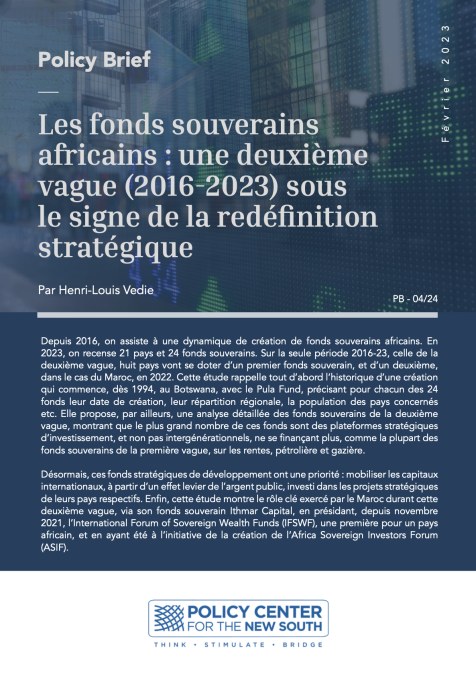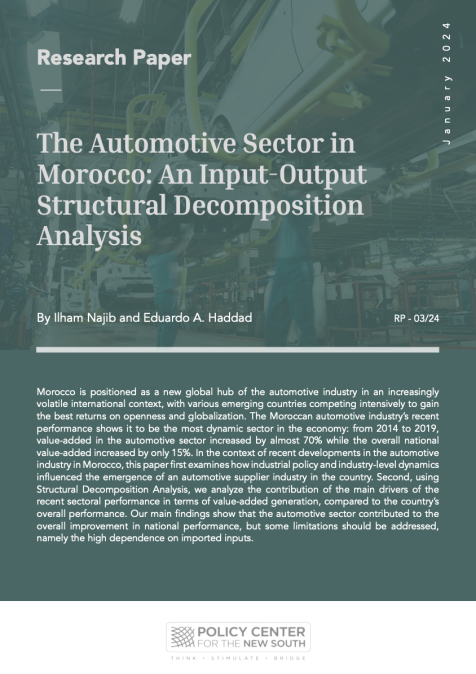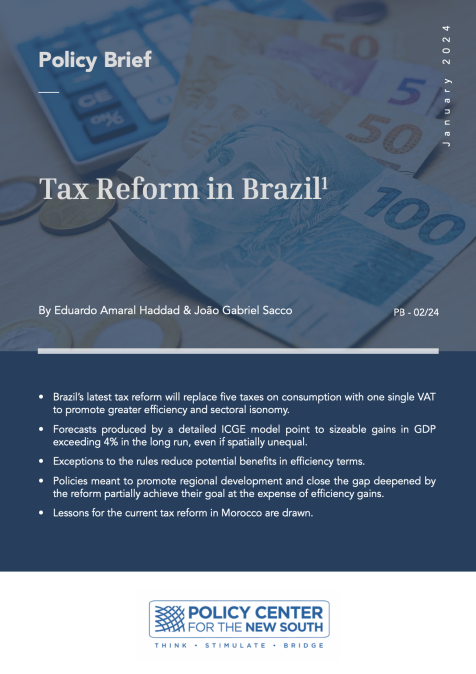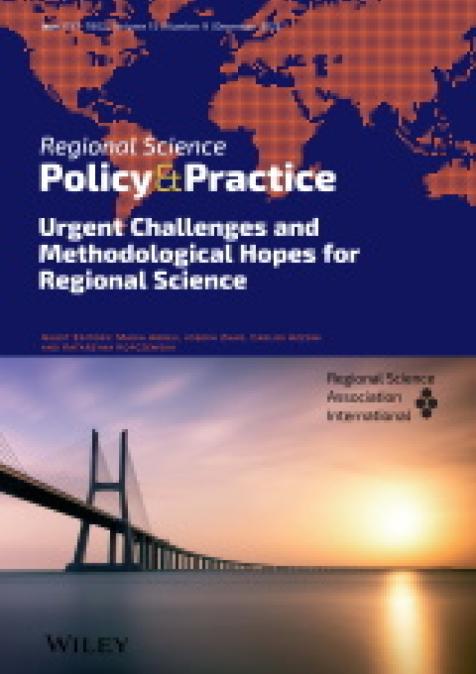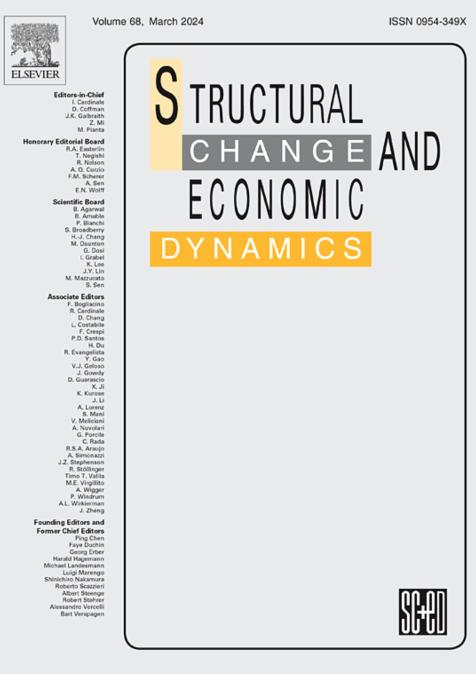Publications /
Policy Brief
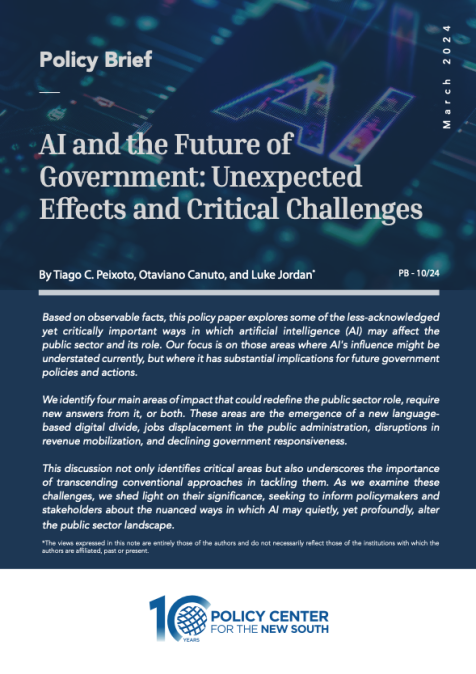
Based on observable facts, this policy paper explores some of the less- acknowledged yet critically important ways in which artificial intelligence (AI) may affect the public sector and its role. Our focus is on those areas where AI's influence might be understated currently, but where it has substantial implications for future government policies and actions.
We identify four main areas of impact that could redefine the public sector role, require new answers from it, or both. These areas are the emergence of a new language-based digital divide, jobs displacement in the public administration, disruptions in revenue mobilization, and declining government responsiveness.
This discussion not only identifies critical areas but also underscores the importance of transcending conventional approaches in tackling them. As we examine these challenges, we shed light on their significance, seeking to inform policymakers and stakeholders about the nuanced ways in which AI may quietly, yet profoundly, alter the public sector landscape.
Artificial intelligence (AI) represents a breakthrough in how machines process information, recognize patterns, and make decisions, often matching or exceeding human capabilities in learning, reasoning, perception, and problem-solving. Unlike traditional computing, which requires explicit instructions for each operation, AI systems can sift through vast datasets, learn from outcomes, and deliver decisions or forecasts with exceptional precision. This opens up possibilities for AI to handle sophisticated tasks across various domains, including natural language understanding, image analysis, complex decision-making, and even autonomous navigation.
Amid this technological leap, anticipation about AI’s potential effects on public-sector performance abound. From a historical standpoint, that is not surprising: each technological innovation brings with it speculation about its impacts on government (Mattelart, 1999; Peixoto, 2013). But as governments grapple with what the future holds, the full scope of AI’s impact remains elusive (Straub et al, 2023).
This policy paper attempts to move beyond commonplace conjectures and, based on observable facts, explores some of the less-acknowledged yet critically important ways in which AI may affect the public sector and its role. Our focus is on those areas where AI’s influence might be understated currently, but has substantial implications for future government policies and actions.
In this analysis we identify four key areas of impact which redefine the public-sector role, require new answers from it, or both. These areas are the emergence of a new language-based digital divide, jobs displacement in the civil service, disruptions in revenue mobilization, and declining government responsiveness.
This discussion not only identifies critical areas but also underscores the importance of transcending conventional approaches in tackling them. As we examine these challenges, we shed light on their significance, seeking to inform policymakers and stakeholders about the nuanced ways in which AI may quietly, yet profoundly, alter the public-sector landscape.
I. THE NEW LANGUAGE-BASED DIGITAL DIVIDE
The role of governments in bridging the digital divide has typically been seen as a mix of promoting investment and policy reform that increases connectivity infrastructure and the affordability of access to the internet. However, the rise of AI, particularly large language models (LLMs), introduces a complex layer to the issue. The efficacy of these AI technologies hinges on the availability and quality of data, requiring datasets (corpus) that are not only extensive but also diverse and representative, to ensure their applicability across a wide spectrum of languages and contexts.
However, given that LLMs are overwhelmingly trained using English-based corpora, this leads to varying performances of LLMs across languages, putting at risk the capacity of non- English speaking countries to reap the full benefits of AI advancements (Ahuja et al, 2023). Recent research highlights this discrepancy, showing that, despite their designed multilingual capabilities, the application of LLMs in critical areas such as the medical field may not provide uniform benefits across different linguistic groups (Mesham et al, 2001; Ògúnrẹ̀mí et al, 2023; Liu et al, 2024). This disparity is further deepened by the limited linguistic coverage of speech recognition technologies, which currently support only a fraction of the world’s more than 7,000 languages (Pratap et al, 2023).
The uneven distribution of AI benefits leads to a disproportionate impact on users from non-English speaking countries, and reduces the ability of most governments to enhance their operations through AI deployments. Countries with low-resourced languages are especially affected. These languages, often lacking a substantial data corpus, encounter significant challenges in effective AI model training. This results in their underrepresentation and leads to inadequate performance in AI applications1.
Nations like Estonia, Denmark, and Slovenia have taken proactive steps by investing in language technologies, recognizing the importance of language to leverage AI’s benefits, and Iceland has started a partnership with OpenAI to increase GPT’s ability to service Icelandic speakers2. Singapore’s ambitious $70 million initiative to develop an LLM that understands languages specific to the Southeast Asia region exemplifies a strategic investment in language models to mitigate the effects of linguistic underrepresentation in AI solutions3.
Countries that are economically disadvantaged and have low-resourced languages stand to be the most impacted by this emerging form of inequality. This situation redefines the digital divide, presenting new challenges that go beyond connectivity infrastructure and internet affordability, and requires a whole new approach towards the development of AI ecosystems that takes into account specific challenges and opportunities related to linguistic, cultural, and epistemic factors4.
II. JOBS DISPLACEMENT IN PUBLIC ADMINISTRATION
AI is bound to reshape many professional functions, as well as the division of labor, and the relationship between workers and physical capital. While the impact of automation has been on repetitive work, the impact of AI tends also to be on tasks performed by skilled labor.
What effect will AI have on productivity and economic growth, and on social inclusion and income distribution? The impact on work processes and the labor market will be a key element in answering these questions.
It can be anticipated that, in segments of the work process where human supervision of AI will continue to be necessary, the trend will be a substantial increase in productivity and demand for work. In other segments, AI could lead to significant displacements or the simple elimination of jobs. As aptly stated by Acemoglu and Johnson (2022), in an article for the International Monetary Fund, “to support shared prosperity, AI needs to complement workers, not replace them” .
The systematic increase in aggregate productivity could, in principle, boost economic growth and, thus, underpin increases in aggregate demand, generating employment opportunities that would compensate for the elimination of jobs. This evolution could also lead to the emergence of new sectors and professional functions, while others would disappear, in a dynamic that will go beyond mere intersectoral reallocation.
In addition to the effects on employment and wage-income distribution, income distribution will also depend on the impact of AI on capital income. This will tend to grow in activities that create and leverage AI technologies or have stakes in AI-driven industries. Depending on the implications in terms of the ‘market power’ of firms, there will be effects on the distribution of capital income and between capital and labor.
Multiple analyses on the impact of AI on the labor market show a substantial impact of AI on jobs (Pizzineli et al, 2023; Restrepo, 2023; Cramarenco et al, 2023; Shen and Zhang, 2024). For instance, a study investigating the potential impacts of LLMs on the U.S. suggests that around 80% of the U.S. workforce could have at least 10% of their work tasks affected by the introduction of LLMs. Furthermore, approximately 19% of workers may see at least 50% of their tasks impacted, with these effects spanning all wage levels, with higher-income jobs potentially facing greater exposure to LLM capabilities and LLM-powered software (Elondou et al, 2023).
An International Monetary Fund study estimated that AI could affect 40% of jobs globally. An estimated 60% of jobs in advanced economies would suffer impacts, with the percentage falling to 40% in emerging economies, and 26% in low-income countries, because of differences in their current employment structures (Cazzaniga et al, 2024)5. The IMF report estimated that half of the jobs impacted will be affected negatively, while the other half may see increases in productivity. The lesser impact on emerging and developing countries will tend to lead to fewer benefits in terms of increased productivity6.
While these analyses of AI’s impact on employment have predominantly focused on the private sector, we argue that it is in the public sector where its effects may be more acutely felt, for two main reasons. First, an overview of these studies suggests a specific susceptibility to disruption in jobs that involve clerical and compliance tasks, as well as those that require a university education. Occupations of this nature are predominantly found within public administrations.7 Second, typical private-sector responses to technological disruptions, such as downsizing or upskilling, are fraught with challenges in the public sector because of policy constraints and political-economy factors (Gibbs, 2020).
Throughout the years, the work of one of the authors [C. Peixoto] has included conversations with public officials overseeing postal services, particularly in countries where the adoption of email was not followed by a surge in e-commerce and parcel deliveries. This has shown first- hand the challenges stemming from reduced demand for traditional tasks or services in the public sector (Matúšková and Madleňáková, 2017; Briest et al, 2019). While the advent of email brought significant disruption to postal services, the impact of AI on the public workforce is likely to be far more dramatic. While more research is needed to assess the specific impacts of AI on public sector employment, governments must prepare proactively for this transformation, to mitigate the inevitable political and economic costs of adaptation.
III. DISRUPTIONS IN REVENUE MOBILIZATION
A new generation of tax reforms will become inevitable as AI technologies disrupt traditional employment models, leading to potential declines in tax receipts. This trend is not unlike the historical shifts in labor dynamics, such as the transition from manual labor to automation. The case of AI, however, is unique in its breadth and depth, affecting a much wider range of jobs. Besides its impact on work, value creation and profit attribution will become harder to define.
The internationalization of services has already brought taxation challenges, but the rise of AI could intensify them and bring additional layers of complexity. Consider, for instance, attribution of profits. AI can operate across borders without an easily established physical presence, making it difficult to attribute profits to specific jurisdictions. Therefore, tax rules based on physical presence or location of value creation will become harder to enforce. Tax authorities may struggle to ascertain whether value is generated by the technology itself, the data it processes, or human inputs into the AI system. AI systems may generate value autonomously, making it challenging to attribute profits to specific jurisdictions based on traditional principles.
Mechanisms of transfer pricing will become increasingly complex to design and implement. Transfer- pricing rules govern transactions between related entities within multinational groups. With AI involved in various aspects of these transactions, determining fair prices becomes challenging. Tax authorities may scrutinize whether intra-group transactions involving AI are priced at arm’s length, but ascertaining the fair value of transactions involving AI technology, data, and intellectual property will become more difficult, leading to a potential growth in the number of disputes between tax authorities and multinational corporations.
As mentioned above, AI will bring labor replacement and displacement. Reduced labor income tax revenue may mean an increased reliance on other forms of taxation, while demand for social welfare programs will increase. As more tasks are automated, there may be a shift from labor taxation to alternative revenue sources, such as taxes on capital or consumption.
The notion of data as an asset—a critical input for AI systems—introduces another challenge. Tax authorities may tackle this issue through valuing and taxing data as an asset, particularly in relation to cross-border data flows and data ownership. The value derived from data goes beyond geographical borders. And taxing the value created by data becomes ever more complex as data is collected, processed, and monetized across multiple jurisdictions.
Compliance with and enforcement of tax laws will become more complex due to AI-driven transactions, which require specialized expertise in tax law and AI technologies. This complexity will also make detecting tax evasion or aggressive tax planning more difficult when AI technologies are involved.
If governments have traditionally struggled to update their tax systems in the face of new technological developments (e.g. Thelen, 2018; Iordache et al, 2022), they now face an even greater challenge. This challenge demands the development of taxation models that embody the principles of good taxation: neutrality, simplicity, certainty, flexibility, and efficiency. While some countries have started exploring AI taxation frameworks, the practical implementation of these models raises questions about their impact on productivity and innovation.
Ultimately, the challenge will be for countries to design taxation systems that do not stifle economic development and, at the same time, can support the necessary social safety nets required for an AI-intensive economy.
IV. DECLINING GOVERNMENT RESPONSIVENESS
Multiple studies have suggested that without proactive measures, AI could significantly exacerbate economic inequality, both within countries and globally (Acemoglu, 2021; Lu and Zhou, 2021, Bell and Korinek, 2023). While this concern has transcended economic circles and has entered the public discourse, the potential impact of AI-driven inequality on representative democracy institutions has been much less examined.
An extensive body of political science research shows that policy decisions in representative democracies often favor the interests of the wealthy, to the detriment of lower-income citizens. For instance, a seminal study by political scientist Martin Gilens (2005) demonstrated that, when the policy preferences of U.S. citizens across different income levels diverge, the resulting policies overwhelmingly cater to the interests of the wealthiest, with minimal consideration for the lower or middle-income groups. Subsequent studies have confirmed similar patterns across various countries and income levels, indicating a systemic issue of unequal responsiveness (Jacobs and Page, 2005; Giger et al, 2012; Carnes, 2013; Rosset et al, 2013; Gilens and Page, 2014; Bernauer et al, 2015; Peters and Ensink, 2015; Carnes and Lupu, 2015; Schakel and Hakhverdian, 2020; Elsässer et al, 2021; Elsässer, and Schäfer, 2023; Soontjens and Persson, 2024).
While these studies have shown different levels of responsiveness to the diverging interests of wealthier individuals and the general population, a common finding is that the interests of the wealthy often align with those of ordinary citizens. Indeed, the concept of consent in modern democracies is largely predicated on this overlap, with the disadvantages faced by the broader population counterbalanced by shared priorities with wealthier segments8. But, as in a Venn diagram where the circles slowly distance from each other, as economic inequality grows, the areas of overlap of preferences between the rich and the poor become smaller and smaller9. This divergence is particularly evident in areas increasingly vital to average citizens, such as taxation and social protection, which fall outside this shared interest zone (Page et al, 2013; Jacobs, 2024). As a result, the growing disparity between the preferences of the wealthy and the general population could lead to political systems becoming less effective at addressing the needs of the less affluent, fostering public distrust and dissatisfaction (Goubin and Hooghe, 2020; Biesntman et al, 2024).
If expectations of widening inequality do materialize, public discontent could be further exacerbated by the potential impact on service delivery. As incomes rise among wealthier groups, their expectations of quality services tend to heighten as well. When these heightened expectations go unmet by the standard of government-provided services, frustration often ensues. Consequently, wealthier individuals may opt for private service provision. As earlier research suggests, this trend of internalizing the costs of state inefficiency, while reducing the burden on public facilities, can paradoxically lead to a decline in the quality of services available to those unable to opt-out (John, 2007; Bhattacharya et al, 2016). This occurs because the exit of these groups reduces the diversity and strength of voices advocating for better public services, lessening the pressure for improvement and responsiveness of these services.
The growing chasm in political responsiveness, compounded by a potential decline in the delivery of public services, will put an additional strain on the responsiveness of representative institutions. Amidst widespread speculation about AI’s direct challenges to democracy, such as deepfakes and misinformation, it is the deepening inequality within an AI-intensive context that may pose the greatest threat to democratic institutions. The fundamental challenge to democracy may not lie in the AI technology itself, but in the economic inequality that it may fuel.
Navigating AI’s Effects on the Public Sector
It may be argued that the potential effects identified above would be offset by AI development and adoption itself. For instance, AI usage in the public sector would augment the public administration’s capacity to produce public value, increase government effectiveness in mobilizing revenues, and enhance the public sector’s capacity to deliver services that are faster, cheaper, and better. While this remains an empirical question, we contend this is an unlikely scenario. The effects we identify— including reduced government revenues, declining responsiveness—are in large part driven by the adoption of AI by the private sector, which takes place at a faster pace than AI adoption by the public sector.
It should be highlighted that the public sector’s slower adoption, regulation, and promotion of AI involve more than just constraints related to resources or technology acquisition. It includes challenges that are either specific to or more pronounced within the public sector, including the development of necessary capacities, the establishment of regulatory frameworks, and the building of public trust. The expectation that AI can enhance public service delivery—which could potentially address inequalities in service provision—is illustrative of this point. Despite significant anticipation that AI will transform public services, the evidence of governments’ ability to effectively leverage digital technologies warrants tempered enthusiasm.
For example, the World Bank’s 2016 World Development Report revealed that less than 20% of digital government projects fully achieve their objectives. Another analysis of 23 digital platforms in the global South showed that, although designed to improve policymakers’ responsiveness to feedback, such platforms often fail to lead to actual action, highlighting a persistent responsiveness gap, despite technological interventions (Peixoto and Fox, 2016). Despite assessments over the years underlining the difficulties, recent literature continues to highlight, across all income levels, governments’ systemic challenges in leveraging technology to bolster public sector performance (Di Giulio and Vecchi, 2023; Kempeneer and Heylen, 2023; Pahlka, 2023; Syed et al., 2023). Specifically in the realm of AI in government, a recent review of 15 initiatives by European governments demonstrated that success largely depends on pre-existing institutional capabilities, which are not easily or rapidly attained (van Noordt and Tangi, 2023).10
Certainly, AI may offer the potential for some governments to mitigate the impacts of an AI-driven economy more effectively. But a more realistic assessment suggests that, without substantial enhancements in capacity, most governments—especially those in developing countries—are likely to struggle in this endeavor. This recognition should not lead one to succumb to technological fatalism. If advancements in AI by itself are not enough, this does not mean that the potential impacts of technology are unavoidable and cannot be shaped by human agency. This brings us to our concluding thoughts on potential ways to navigate the challenges presented in this policy paper.
When it comes to the issue of the language-based divide, a solution increasingly adopted by some countries is developing and refining AI models in local languages. In countries with low-resource languages, several strategies can expedite the development of AI models. First, promoting open- source models can lower the costs and efforts of building models, while facilitating collaboration, innovation, and the creation of multilingual and cross-lingual systems (Beniwal et al, 2024; Nagle, 2019; Qi and Bisazza, 2023). Second, governments can maximize private sector investments in areas with evident market demand. In this case, the main role of the public sector is to provide the necessary infrastructure, incentives, and regulatory framework to support private endeavors. Third, through resource-pooling among countries with similar languages, economies of scale can be achieved while enhancing the quality and representativeness of models. This approach not only improves models but may also lower the barriers for cooperation in promoting common AI governance standards. Fourth, by granting third parties access to public sector data, governments can enlarge the corpus of data available in local languages, while encouraging private sector innovation (Beraja et al, 2023). Finally, international organizations and development agencies can play a proactive role by adopting a ‘no language left behind’ pledge, offering technical assistance, funding, advocacy, and platforms for collaboration.
In addressing government revenues, international cooperation becomes crucial for tackling issues related to tax policies and enforcement, such as preventing tax avoidance, profit shifting, double taxation, and tax competition. The evolving nature of AI technologies demands a concerted effort among governments, businesses, and international organizations to craft tax policies that are not only equitable and efficient, but also flexible enough to adapt to these changes. This endeavor may require the modernization of tax laws, the introduction of innovative tax concepts, improved cross-border collaboration, and increased transparency in AI-related financial activities. Collective efforts will remain essential to pave the way for a more robust and fair international tax system in the era of AI.
The subsequent challenges—job displacement in the public administration and declining government responsiveness—are even more complex. They are far less technical, entailing conflicting interests, values, and visions of the future. And because they directly affect the relationship between the state and its citizens, the way these issues are handled is likely to have a determinant effect on the legitimacy and effectiveness of the state. Addressing these challenges calls for a comprehensive approach that includes administrative and political reforms. Moving forward will require unprecedented proactivity from governments as they attempt to anticipate the dynamic impacts of AI, balancing technological progress with social and economic stability. Disruptions in public administration organization and reduced government capacity to respond to citizens’ needs risk eroding public trust and the perceived legitimacy of state institutions if not properly addressed.
This weakening of state legitimacy opens pathways to two entirely different scenarios. First, driven by a perception that current systems are ill-equipped to manage the challenges introduced by AI, citizens may resort to supporting populist and authoritarian regimes. In such an environment, in which trust in traditional democratic processes erodes, the allure of simplified, albeit undemocratic solutions, can gain traction. In a second scenario, disruptions caused by AI adoption may become an opportunity for reimagining institutions, putting forward democratic innovations that allow governments to align more closely with the needs and expectations of a rapidly changing society11.
Governments worldwide can draw inspiration from the initiative that led to Brazil’s Internet Bill of Rights (Marco Civil da Internet)—a pioneering legal framework that established Brazil as a forerunner in technology governance and crowdlaw (Simone Noveck, 2018; Yilma, 2022; Celeste,2022; Hoffmann, 2022)12. The Bill of Rights, notable for setting enforceable principles, rights, and duties for internet users and providers, addresses critical aspects including net neutrality, freedom of expression, and data protection. The formulation of the Bill of Rights was marked by an exceptionally open and inclusive participatory approach. This approach deftly integrated crowdsourcing, public consultations, and debates as core elements, encouraging active involvement from a diverse range of stakeholders including civil society, government entities, academia, the technology sector, the business community, and importantly, the general public. Any interested citizen was able to contribute, thereby capturing a broad spectrum of public opinion and fostering a truly inclusive process. The open and deliberative nature of this consensus-building approach were instrumental not only in enhancing the development of the Bill of Rights, but also in securing the widespread stakeholder support crucial for its adoption and enforcement (Affonso Souza et al, 2017).
Combined with open processes such as the Brazilian example, the incorporation of citizens’ assemblies could further enhance the legitimacy and efficacy of policymaking in the age of AI (Steinberg and Peixoto, 2019; Ovadya, 2023). Citizens’ assemblies, by design, typically gather a small sample of the population—through lottery, stratification, or both—to deliberate on specific issues, providing a platform for informed, inclusive, and diverse perspectives (Landemore, 2020). This approach can be particularly effective in tackling complex and contentious issues driven by AI adoption, on which traditional political processes may fall short in addressing the nuanced needs and concerns of stakeholders, particularly the less well-off13. By combining citizens’ assemblies with open participatory initiatives such as that of the Brazilian Internet Bill of Rights, governments can ensure that reforms are crafted with technical expertise and democratic depth, reflecting a broader spectrum of societal values and perspectives14,15.
To conclude, AI presents multiple challenges for governments, ranging from the emergence of a new language-based digital divide, to shifts in public job structures and revenue mobilization, culminating in potential impacts on government responsiveness and democratic institutions. The impending task for governments in an era increasingly influenced by AI is to shift from being solely AI-driven to being guided by the collective intelligence of those affected by technological progress and, more broadly, by public decisions. This inflection moment demands not just a recognition of the need for change, but also an unwavering commitment to democratic renewal.
REFERENCES
-
Acemoglu, D., 2021. Harms of AI (No. w29247). National Bureau of Economic Research.
-
Acemoglu, D., Johnson, S., 2023. Rebalancing AI. International Monetary Fund.
-
Affonso Souza, C., Steibel, F. and Lemos, R., 2017. Notes on the creation and impacts of Brazil’s Internet Bill of Rights. The theory and practice of legislation, 5(1), pp.73-94.
-
Ahuja, K., Hada, R., Ochieng, M., Jain, P., Diddee, H., Maina, S., Ganu, T., Segal, S., Axmed, M., Bali, K. and Sitaram, S., 2023. Mega: Multilingual evaluation of generative ai. arXiv preprint arXiv:2303.12528.
-
Bhattacharya, S., Saha, S. and Banerjee, S., 2016. Income inequality and the quality of public services: A developing country perspective. Journal of Development Economics, 123, pp.1-17.
-
Bell, S.A. and Korinek, A., 2023. AI’s Economic Peril. Journal of Democracy, 34(4), pp.151- 161.
-
Beniwal, H. and Singh, M., 2024. Cross-lingual Editing in Multilingual Language Models. arXiv preprint arXiv:2401.10521.
-
Beraja, M., Yang, D.Y. and Yuchtman, N., 2023. Data-intensive innovation and the State: evidence from AI firms in China. The Review of Economic Studies, 90(4), pp.1701-1723.
-
Bernauer, J., Giger, N. and Rosset, J., 2015. Mind the gap: Do proportional electoral systems foster a more equal representation of women and men, poor and rich?. International Political Science Review, 36(1), pp.78-98.
-
Bienstman, S., Hense, S. and Gangl, M., 2024. Explaining the ‘democratic malaise ‘in unequal societies: Inequality, external efficacy and political trust. European Journal of Political Research, 63(1), pp.172-191.
-
Briest, P., Dragendorf, J., Ecker, T., Mohr, D. and Neuhaus, F., 2019. The endgame for postal networks: How to win in the age of e-commerce. McKinsey Company.
-
Buchanan, J.M. and Tullock, G., 1965. The calculus of consent: Logical foundations of constitutional democracy (Vol. 100). University of Michigan press.
-
Canuto, O. 2024. How Will Artificial Intelligence Affect the Economy? Policy Center for the New South, January 26.
-
Capraro, V., Lentsch, A., Acemoglu, D., Akgun, S., Akhmedova, A., Bilancini, E., Bonnefon, J.F., Brañas-Garza, P., Butera, L., Douglas, K.M. and Everett, J.A., 2023. The impact of generative artificial intelligence on socioeconomic inequalities and policy making. arXiv preprint arXiv:2401.05377.
-
Carnes, N., 2013. White-collar government: The hidden role of class in economic policy making. University of Chicago Press.
-
Carnes, N., & Lupu, N. (2015). Rethinking the comparative perspective on class and representation: Evidence from Latin America. American Journal of Political Science, 59(1), 1-18.
-
Cazzaniga, M., Jaumotte, F., Li, L., Melina, G., Panton, A.J., Pizzinelli, C., Rockall, E.J. and Tavares, M.M., 2024. Gen-AI: Artificial Intelligence and the Future of Work. IMF, 2024 (001).
-
Celeste, E., 2022. Digital Constitutionalism: The Role of Internet Bills of Rights. Routledge.
-
Cramarenco, R.E., Burcă-Voicu, M.I. and Dabija, D.C., 2023. The impact of artificial intelligence (AI) on employees’ skills and well-being in global labor markets: A systematic review. Oeconomia Copernicana, 14(3), pp.731-767.
-
27.Gibbs, D., 2020. Civil service reform, self‐selection, and bureaucratic performance. Economics & Politics, 32(2), pp.279-304.
-
Giger, N., Rosset, J. and Bernauer, J., 2012. The poor political representation of the poor in a comparative perspective. Representation, 48(1), pp.47-61.
-
Gilens, M. (2005). Inequality and democratic responsiveness. Public Opinion Quarterly, 69(5), 778-796.
-
Gilens, M. and Page, B.I., 2014. Testing theories of American politics: Elites, interest groups, and average citizens. Perspectives on politics, 12(3), pp.564-581.
-
Gimpel, L. and McBride, K., 2023. Contextualizing the Challenges and Motivating Factors Associated with the Usage of Ai in and by the Public Sector: Initial Insights from Rwanda’s Mbaza Chatbot Project. Available at SSRN 4327495.
-
Goubin, S. and Hooghe, M., 2020. The effect of inequality on the relation between socioeconomic stratification and political trust in Europe. Social Justice Research, 33, pp.219-247.
-
Henman, P., 2020. Improving public services using artificial intelligence: possibilities, pitfalls, governance. Asia Pacific Journal of Public Administration, 42(4), pp.209-221.
-
Hoffmann, A., 2022. 9 Regulating the Internet in Times of Mass Surveillance: A Universal Global Space with Universal Human Rights?. Problematising Intelligence Studies: Towards A New Research Agenda. Routledge.
-
DfE (Department for Education), 2023. The impact of AI on UK jobs and training. London: Department for Education.
-
Di Giulio, M. and Vecchi, G., 2023. Implementing digitalization in the public sector. Technologies, agency, and governance. Public Policy and Administration, 38(2), pp.133- 158.
-
Elsässer, L., Hense, S. and Schäfer, A., 2021. Not just money: unequal responsiveness in egalitarian democracies. Journal of European Public Policy, 28(12), pp.1890-1908.
-
Elsässer, L. and Schäfer, A., 2023. Political Inequality in Rich Democracies. Annual Review of Political Science, 26, pp.469-487.
-
Eloundou, T., Manning, S., Mishkin, P. and Rock, D., 2023. Gpts are gpts: An early look at the labor market impact potential of large language models. arXiv preprint arXiv:2303.10130.
-
Engstrom, D.F., Ho, D.E., Sharkey, C.M. and Cuéllar, M.F., 2020. Government by algorithm: Artificial intelligence in federal administrative agencies. NYU School of Law, Public Law Research Paper, (20-54).
-
Fernandez-Villaverde, J. 2023. La economía de la inteligencia artificial: unas ideas básicas, La mano visible, University of Pennsylvania, May 1st.
-
35. Iordache, C., Raats, T. and Donders, K., 2022. The» Netflix Tax»: An Analysis of Investment Obligations for On-Demand Audiovisual Services in The European Union. International Journal of Communication, 16(2022), pp.545-565.
36.Jacobs, J., 2024. The artificial intelligence shock and socio-political polarization. Technological Forecasting and Social Change, 199, p.123006.
-
Jacobs, Lawrence R., and Benjamin I. Page. «Who influences US foreign policy?.» American political science review 99.1 (2005): 107-123.
-
John, J.D., 2007. Albert Hirschman’s exit-voice framework and its relevance to problems of public education performance in Latin America. Oxford Development Studies, 35(3), pp.295-327.
-
40. Korinek, A. and Stiglitz, J.E., 2021. Artificial intelligence, globalization, and strategies for economic development (No. w28453). National Bureau of Economic Research.
-
Landemore, H., 2020. Open democracy: Reinventing popular rule for the twenty-first century. Princeton University Press.
-
Landemore, H., 2021. Open democracy and digital technologies. Digital technology and democratic theory, pp.62-89.
-
Liu, X., Wu, J., Shao, A., Shen, W., Ye, P., Wang, Y., Ye, J., Jin, K. and Yang, J., 2024. Uncovering Language Disparity of ChatGPT on Retinal Vascular Disease Classification: Cross-Sectional Study. Journal of Medical Internet Research, 26(1), p.e51926.
-
Lu, Y. and Zhou, Y., 2021. A review on the economics of artificial intelligence. Journal of Economic Surveys, 35(4), pp.1045-1072.
-
Martí, J.L. and Simone Noveck, B., 2022. Introduction to the Special Issue on Crowdlaw and Emergency Collective Intelligence. Digital Government: Research and Practice, 3(2), pp.1-7.
-
Mathisen, R. and Peters, Y., 2023. Political Participation and Unequal Representation. Unequal Democracies: Public Policy, Responsiveness, and Redistribution in an Era of Rising Economic Inequality, p.196.
-
Mattelart, A., 1999. La communication et la promesse de rédemption. Quaderni, 40(1), pp.69-78.
-
Matúšková, M. and Madleňáková, L., 2017. The impact of the electronic services to the universal postal services. Procedia Engineering, 178, pp.258-266.
-
Mesham, S., Hayward, L., Shapiro, J., & Buys, J. (2021). Low-resource language modelling of South African languages. arXiv preprint arXiv:2104.00772.
-
Nagle, F., 2019. Government technology policy, social value, and national competitiveness. Harvard Business School Strategy Unit Working Paper, (19-103).
-
Noveck, B.S., 2018. Crowdlaw: Collective intelligence and lawmaking. Analyse & Kritik, 40(2), pp.359-380.
-
Kempeneer, S. and Heylen, F., 2023. Virtual state, where are you? A literature review, framework and agenda for failed digital transformation. Big Data & Society, 10(1), p.20539517231160528.
-
-
Ògúnrẹ̀mí, T., Nekoto, W.O. and Samuel, S., 2023. Decolonizing NLP for “Low-resource Languages”: Applying Abebe Birhane’s Relational Ethics. GRACE: Global Review of AI Community Ethics, 1(1).
-
Ovadya, A., 2023. Reimagining democracy for ai. Journal of Democracy, 34(4), pp.162-170.
-
Pahlka, J., 2023. Recoding America: why government is failing in the digital age and how we can do better. Metropolitan Books.
-
Page, B.I., Bartels, L.M. and Seawright, J., 2013. Democracy and the policy preferences of wealthy Americans. Perspectives on Politics, 11(1), pp.51-73.
-
Peixoto, T.C., 2013. Open parliaments: technological enactment in state legislatures (Doctoral dissertation). European University Institute.
-
Peixoto, T.C. and Spada, P., 2023. Reflections on the representativeness of citizens’ assemblies and similar innovations. Democracyspot.
-
Peixoto T.C., Fox J., 2016. When does ICT-enabled citizen voice lead to government responsiveness?. IDS Bulletin; 47:23–40
-
Peixoto, T.C. and Steinberg, T., 2019. Citizen engagement: Emerging digital technologies create new risks and value. World Bank.
-
Peters, Y. and Ensink, S.J., 2015. Differential responsiveness in Europe: The effects of preference difference and electoral participation. West European Politics, 38(3), pp.577- 600.
-
Pizzinelli, C., Panton, A., Mendes Tavares, M., Cazzaniga, M. and Li, L., 2023. Labor Market Exposure to AI: Cross-Country Differences and Distributional Implications. IMF.
-
Pogrebinschi, T., 2023. Innovating Democracy?: The Means and Ends of Citizen Participation in Latin America. Cambridge University Press.
-
Pratap, V., Tjandra, A., Shi, B., Tomasello, P., Babu, A., Kundu, S., Elkahky, A., Ni, Z., Vyas, A., Fazel-Zarandi, M. and Baevski, A., 2023. Scaling speech technology to 1,000+ languages. arXiv preprint arXiv:2305.13516.
-
Qi, J., Fernández, R. and Bisazza, A., 2023. Cross-lingual consistency of factual knowledge in multilingual language models. arXiv preprint arXiv:2310.10378.
-
Restrepo, P. (2023). Automation: Theory, Evidence, and Outlook. NBER.
-
Rosset, J., Giger, N. and Bernauer, J., 2013. More money, fewer problems? Cross-level effects of economic deprivation on political representation. West European Politics, 36(4), pp.817-835.
-
Schakel, W., Burgoon, B. and Hakhverdian, A., 2020. Real but unequal representation in welfare state reform. Politics & Society, 48(1), pp.131-163.
-
Shen, Y. and Zhang, X., 2024. The impact of artificial intelligence on employment: the role of virtual agglomeration. Humanities and Social Sciences Communications, 11(1), pp.1-14.
-
Soontjens, K. and Persson, M., 2024. Lacking Incentives, Not Information. Why Politicians tend to be Less Responsive to Lower‐Income Citizens. Legislative Studies Quarterly.
-
Straub, V.J., Morgan, D., Bright, J. and Margetts, H., 2023. Artificial intelligence in government: Concepts, standards, and a unified framework. Government Information Quarterly, 40(4), p.101881.
-
Syed, R., Bandara, W. and Eden, R., 2023. Public sector digital transformation barriers: A developing country experience. Information Polity, 28(1), pp.5-27.
-
Thelen, K., 2018. Regulating Uber: The politics of the platform economy in Europe and the United States. Perspectives on Politics, 16(4), pp.938-953.
-
Van Dijk, L., Vanbroekhoven, W. and Marien, S., 2024. Opinion incongruence and public support for direct decision‐making. European Journal of Political Research.
-
van Noordt, C. and Tangi, L., 2023. The dynamics of AI capability and its influence on public value creation of AI within public administration. Government Information Quarterly, 40(4), p.101860.
-
World Bank Group, 2016. World development report 2016: Digital dividends. World Bank Publications.
-
Yilma, K.M., 2022. Bill of rights for the 21st century: Some lessons from the internet bill of rights movement. The International Journal of Human Rights, 26(4), pp.701-716.
-

